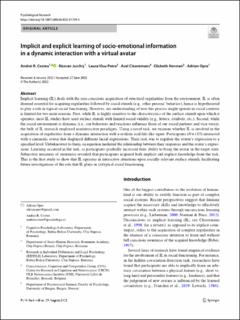Implicit and explicit learning of socio-emotional information in a dynamic interaction with a virtual avatar
Costea, Andrei R.; Jurchiș, Răzvan; Visu-Petra, Laura; Cleeremans, Axel; Norman, Elisabeth; Opre, Adrian
Journal article, Peer reviewed
Published version

Åpne
Permanent lenke
https://hdl.handle.net/11250/3034586Utgivelsesdato
2022Metadata
Vis full innførselSamlinger
Sammendrag
Implicit learning (IL) deals with the non-conscious acquisition of structural regularities from the environment. IL is often deemed essential for acquiring regularities followed by social stimuli (e.g., other persons’ behavior), hence is hypothesized to play a role in typical social functioning. However, our understanding of how this process might operate in social contexts is limited for two main reasons. First, while IL is highly sensitive to the characteristics of the surface stimuli upon which it operates, most IL studies have used surface stimuli with limited social validity (e.g., letters, symbols, etc.). Second, while the social environment is dynamic (i.e., our behaviors and reactions influence those of our social partners and vice-versa), the bulk of IL research employed noninteractive paradigms. Using a novel task, we examine whether IL is involved in the acquisition of regularities from a dynamic interaction with a realistic real-life-like agent. Participants (N = 115) interacted with a cinematic avatar that displayed different facial expressions. Their task was to regulate the avatar’s expression to a specified level. Unbeknownst to them, an equation mediated the relationship between their responses and the avatar’s expressions. Learning occurred in the task, as participants gradually increased their ability to bring the avatar in the target state. Subjective measures of awareness revealed that participants acquired both implicit and explicit knowledge from the task. This is the first study to show that IL operates in interactive situations upon socially relevant surface stimuli, facilitating future investigations of the role that IL plays in (a)typical social functioning.
